Toyota’s and Kobe University’s Progress in LENR
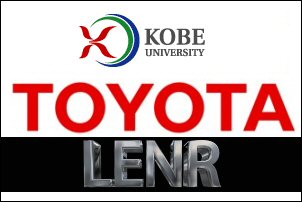
Sept. 26, 2012 – By Steven B. Krivit –
[This is the third of a four-part series. Part 1 is here. Part 2 is here.]
This article continues the story of the development of low-energy nuclear reaction nanomaterial research in Japan. After researchers at Kobe University reported their work on the nanomaterial and hydrogen-isotope-gas absorption method of LENRs in 2009, researchers at the Toyota Central Research and Development Laboratories attempted a replication within a year.
Researchers from Toyota first reported low-energy nuclear reaction research in 2007. In July that year, Tatsumi Hioki, N. Takahashi and Motohiro Tomoyoshi reported that they had attempted to replicate the deuterium gas permeation method developed by Yasuhiro Iwamura at Mitsubishi Heavy Industries. In 2010, the Toyota team first reported its attempts to replicate Arata/Zhang’s work at Osaka.
2010 – Toyota
In 2010, Tatsumi Hioki, on behalf of the Toyota research group and a researcher from Tohoku University, presented the results of their LENR work at the 10th Meeting of the Japan CF-Research Society. Their replication followed on the work of the Arata/Zhang group and the Kitamura group at Kobe. They explained the difference between the first and second phases of this type of experiment in more detail.[1]
According to the Toyota researchers, the heat evolution took place in two phases. In the first phase, during pressurizing, the samples go from 0 to 1 MPa. In the second phase, the sample was kept under a fixed pressure of 1 MPa. According to the researchers, the heat generated in the first phase was largely explained by taking into account two chemical reactions: the water formation reaction and the hydride or deuteride formation reaction. The researchers did not expect any heat generation to take place in the second phase, but, just as Arata and Zhang did, they saw low levels – 50 to 100 milliWatts – of heat production when the samples were loaded with deuterium gas.
“It was noted that, in the second stage, where the heat generated from chemical reactions was hardly expected to occur, a small heat power was observed intermittently when the samples were loaded with deuterium gas,” the Toyota researchers wrote.
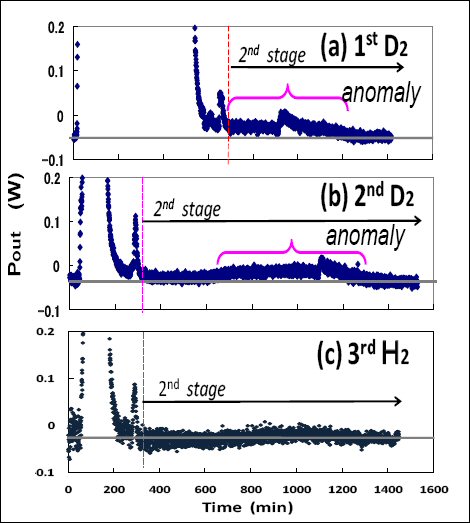
Figure 10 from Toyota group 2010 paper: “Heat power and gas pressure as a function of time for 30wt%Pd/ZrO2 nanocomposite: (a) the first cycle loading with D2, (b) the second cycle loading with D2, and (c) the third cycle loading with H2. The vertical dotted line indicates the boundary between the first stage and the second stage, and the horizontal gray lines the zero level of [power] out.”
2010 – Kobe University
At the 10th Meeting of the Japan CF-Research Society, the Kobe researchers also presented new results.[2] They reported that they used palladium-nickel-zirconium-oxide (PdNiZr) nano-compounds fabricated and supplied by Brian Ahern, an independent U.S. researcher and expert in material science. Ahern was attempting to replicate Arata/Zhang, who had reported using the PdNiZr alloy in 2009.[3]
When Ahern used the PdNiZr nano-compounds in his own experiments, he saw a very high loading ratio of hydrogen and moderate heat evolution, he told the Kobe researchers.
Similar to that of Arata/Zhang, the Ahern PdNiZr nano-compound contained very little palladium, only 4 percent, but it contained 29 percent nickel. The rest, 67 percent, was zirconium.
For the benefit of newer readers, throughout the history of this field, it has been well-known, for reasons that are not so clear, that experiments with deuterium work well – that is, produce anomalous heat – when used with palladium, and that experiments with hydrogen work with nickel. The pairs do not generally work when they are switched.
The first surprise for the Kobe researchers was that, instead of obtaining a high loading ratio around 1.0, they found that, in both deuterium and hydrogen gas experiments using Ahern’s materials, they obtained an extraordinarily high loading ratio of 3.3 for both for deuterium and hydrogen gas.
They also saw maximum output heat of 0.4 W with protium gas and 0.2 W with deuterium gas. In the graph below, look for the Watts-hydrogen output trace labeled “WH” and the deuterium trace labeled “WD”. Nevertheless, it was encouraging because the heat release sustained (with no additional input) for more than 1,000 minutes.
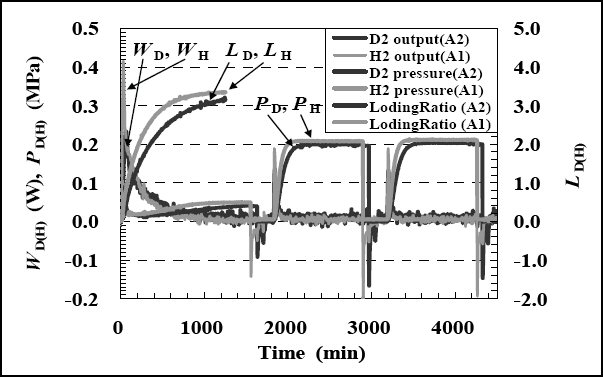
Fig. 3 from Kobe group paper: ” Evolution of heat, pressure in the reaction chamber after introduction of D2 (or H2) gas and the time-dependent loading ratio (H-PNZ2B1#1 and DPNZ2B2#1)”
2011 – Ahern Adds Copper
In 2011, Andrea Rossi, a former convicted criminal with a string of failed energy ventures in his past, sought media attention and credibility for a device he said could produce extraordinary levels of LENR excess heat. To a certain degree, his device appeared to copy the work of Francesco Piantelli. Piantelli is a retired professor of physics from the University of Sienna in Italy and has a long history of credible, published LENR research.
Piantelli’s main interest was working with nickel and hydrogen, not palladium and deuterium. Although Rossi failed in his attempt to gain credibility for his work, he succeeded in bringing far more attention to the nickel-hydrogen LENR system than Piantelli had. In fact, the attention Rossi brought to nickel-hydrogen LENR research finally convinced many senior LENR researchers to take nickel-hydrogen seriously. For the previous decade, they had been skeptical of nickel-hydrogen LENR work. At one point, Rossi began talking about copper either as a starting or an ending material in his device; Rossi was never clear about the details of his work. Nevertheless, Ahern wondered whether adding copper to the nanopowder might make a difference.
In May 2011, Ahern began adding copper to his samples. He told New Energy Times that he got some positive results in his experiments and that he sent his samples to Kobe University for confirmation.
“Kitamura used my materials in May 2011 and repeated my results,” Ahern wrote. “They reported that my materials were the best they ever tested.”
2011 – Kobe Adds Copper
In December 2011, the Kobe researchers reported their results at the 12th Meeting of the Japan CF-Research Society.[4]
The first thing they found was that nano-composite samples of Ni CuZr oxide did not produce observable absorption of hydrogen at room temperature. That material produced no anomalous heat, either. So they tried to heat the system, first bringing it to 300 K. No positive results. The graph below shows measured heat for both the deuterium and hydrogen runs; the power is indistinguishable from the baseline – that is, no anomalous heat.
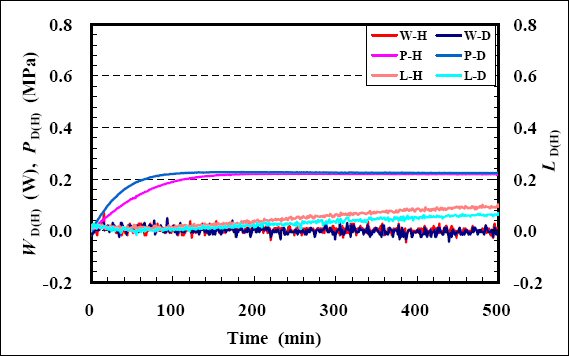
Fig. 2 from Kobe group 2011 paper: “Results of D2/H2 absorption runs for Cu•Ni•Zr oxide compounds at 300K; the run numbers are D-CNZ1#1 and H-CNZ2#1.”
So they raised the temperature to 373 K. Things began to happen. They began to see absorption of both deuterium and hydrogen into the material in each respective experiment. When they got up to 525 K, they saw a 1.0 loading ratio with both gases.
At 523 K, things got more interesting. The figure below shows that the hydrogen experiment began to go significantly exothermic, up to 2 Watts of excess. Then the deuterium experiment inexplicably went endothermic. They calculated that the hydrogen run showed an exothermic tendency, with a specific output energy reaching 300 eV per nickel atom. In the Kobe researchers’ opinion, the specific output energy of 300 eV per nickel atom is very unusual and too high to be explained only by known chemical processes.
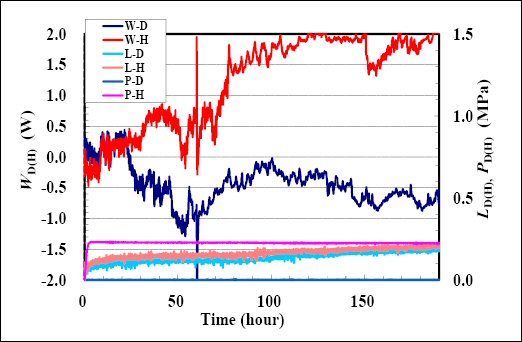
Fig. 5d from Kobe group 2011 paper: “Variation of the thermal output power WD(H)(t), the pressure PD(H)(t) and the time-dependent loading ratio LD(H)(t) in the run D(H)-CNZ1(2)#5_523K_2.”
They anticipated that more activation of the gas absorption reaction would take place at higher temperatures. They were right. They ran experiments up to 573 K by applying heater input power of up to 105 W. This temperature realm was too hot for water mass-flow calorimetry so they used other calorimetry methods, described in their 2011 paper at the 10th Meeting of the Japan CF-Research Society .They wrote that, based on their calorimetry at these higher temperatures, the uncertainty was +/- 0.2 Watts.
The Kobe researchers also wrote in their paper at the December 2012 10th Meeting of the Japan CF-Research Society that the deuterium gas heat production eventually caught up to the hydrogen gas heat production after they let it run for several weeks.
2012 – Kobe
At ICCF-17, the Kobe group reported further progress and more repeatable results. They reported the results of another experiment performed with hydrogen at 534 K and again found an excess-heat output exceeding 1.0 W. The percent of excess heat is small because the input heater power is 70 W, but again, they were encouraged by the fact that the excess heat continued for 40 hours. The run shown below is without copper.[5]
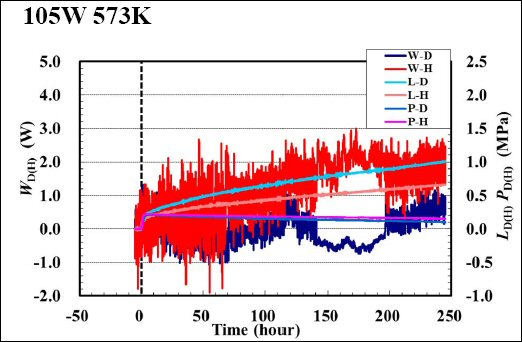
Slide 15 from Kobe group presentation: “Heat release with elevated temperature run using Ni(0.36)/ZrO2”
Next, they went up to 573 K with the hydrogen run, this time with the copper addition. The excess heat gradually increased to 2 W. The excess heat ran for 250 hours. The benefits of the copper addition, the researchers wrote, led to a 10-fold increase in heat production over the samples without copper.
The researchers were able to perform another repetition and improve on their results. In the graph below, the researchers observed periods of exothermic reactions for both hydrogen and deuterium that continued for more than 100 hours. In the hydrogen run, excess heat gradually increases to about 2 W as the temperature reaches 523 K. When the temperature went up to 573 K, output heat for the hydrogen experiment reached 4.0 W, a power level twice as large as the sample without copper. Kitamura explained the breaks in the graph to New Energy Times.
“The breaks in the experiment occurred when the student running the experiment had to stop and then restart the experiment, so the student could participate in university entrance exams safely without the risk of causing any interference from an unexpected event,” Kitamura wrote.
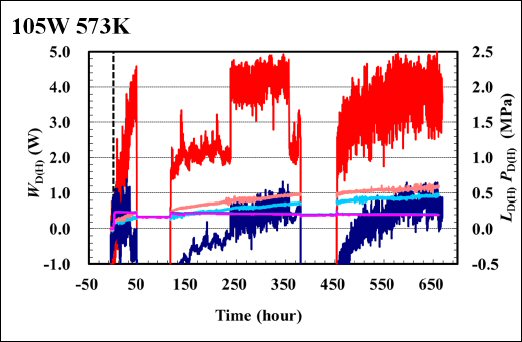
Slide 15 from Kobe group presentation: “Heat release with elevated temperature run using Cu(0.08)Ni(0.35)/ZrO2”
2012 – Toyota
The Toyota group also presented at ICCF-17 more replications of the Arata/Zhang palladium-deuterium system. The group did not, however, report attempts to use nickel or copper in its alloys.
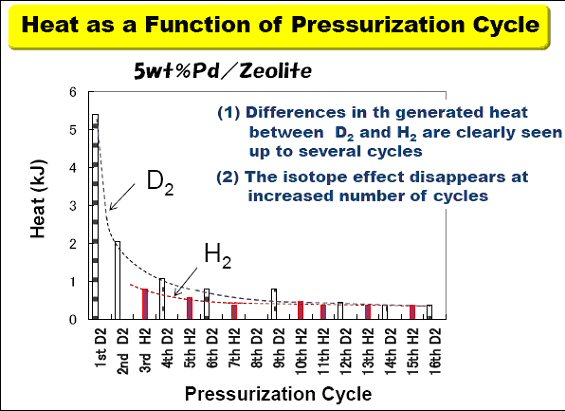
Slide 16 from Toyota group presentation showing generated-heat difference between deuterium and hydrogen gas experiments.
Although the Toyota researchers did not report any significant quantitative heat effects, they did report repeatable qualitative heat effects that varied based on the use of deuterium or hydrogen isotope gas in the palladium system.[6]
[Part 4 in this series will publish tomorrow.]
1. “Hioki, Tatsumi, Azuma, Hirozumi, Nishi, Teppei, Itoh, Akio, Hibi, Shogo, Motohiro, Tomoyoshi and Kasagi, Jirohta, “Hydrogen/Deuterium Absorption Capacity of Pd Nanomaterials and Its Relation With Heat Generated Upon Loading of Hydrogen Isotope Gases,” JCF-10, 2010
2. Sakoh, Hideyuki , Miyoshi, Yuuki, Taniike, Akira, Kitamura, Akira, Takahashi, Akito, Seto, Reiko, Fujita, Yushi, “Hydrogen Isotope Absorption/Adsorption Characteristics of Ni-Pd Binary Nano-Particles,” JCF10, 2010
3. Arata, Yoshiaki, Zhang, Yue-Chang and Wang, X.F., “Production of Helium and Energy in the ‘Solid Fusion'” (PowerPoint slides) in 15th International Conference on Condensed Matter Nuclear Science, Rome, Italy, 2009
4. Miyoshi, Yuuki, Sakoh, Hideyuki, Taniike, Akira, Kitamura, Akira, Takahashi, Akito, Murota, Tadatoshi, Tahara, Tomonori, “Gas-Phase Hydrogen Isotope Absorption/Adsorption Characteristics of a Ni-Based Sample,” JCF12
5. Sakoh, Hideyuki, Miyoshi, Yuuki, Taniike, Akira, Furuyama, Yuichi, Kitamura, A., Takahashi, A., Seto, Reiko, Fujita, Yushi, Murota, Tadatoshi and Tahara, Tomonori, “Hydrogen Isotope Absorption and Heat Release Characteristics of a Ni-Based Sample,” ICCF-17
6. Hioki, Tatsumi, Sugimoto, Noriaki, Nishi, Teppei, Itoh, Akio and Motohiro, Tomoyoshi, “Isotope Effect for Heat Generation Upon Pressurizing Nano-Pd/Silica Systems With Hydrogen Isotope Gases,” ICCF-17
Questions? Comments? Submit a Letter to the Editor.

